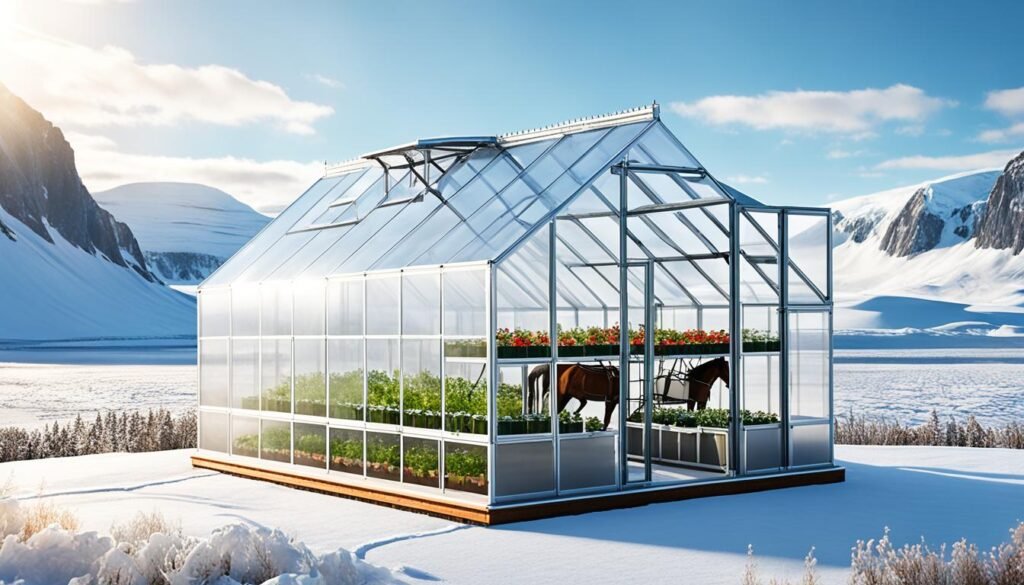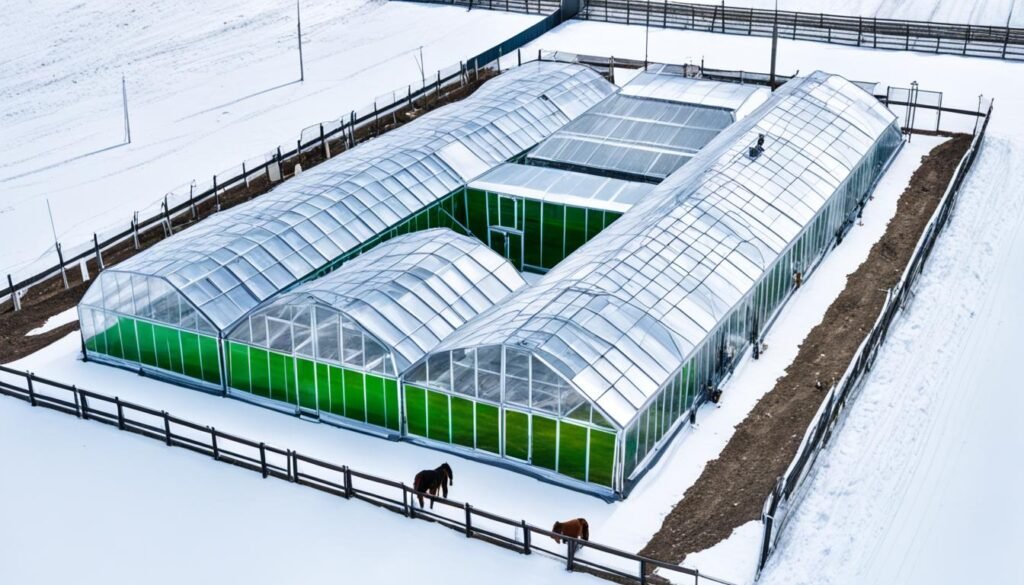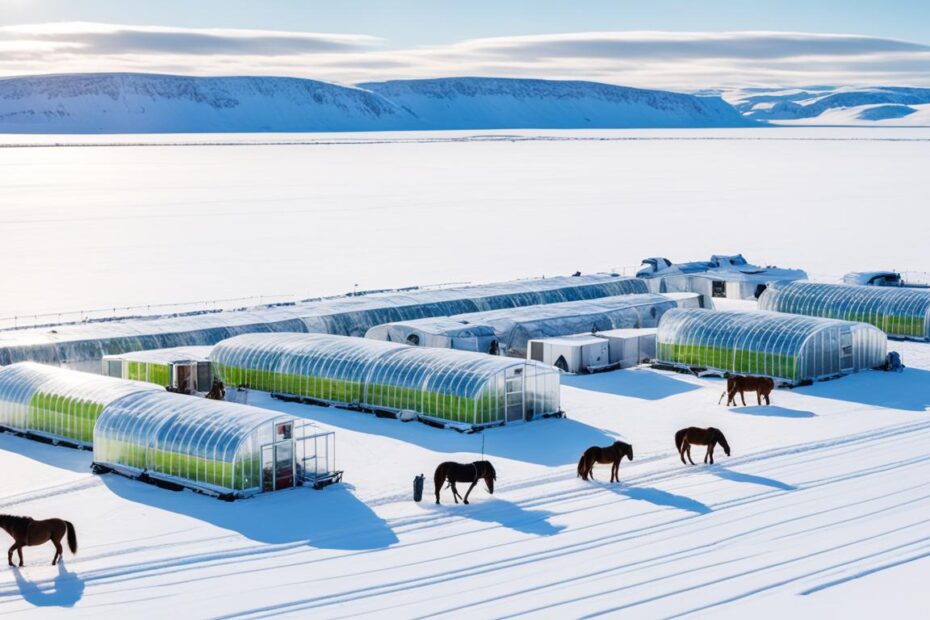In the heart of the Arctic, where the winter winds howl and temperatures plummet, a new era of sustainable agriculture is taking root. Introducing the innovative concept of modular, horse-powered greenhouses, designed to harness the power of nature and provide a reliable source of fresh produce for northern communities.
These cutting-edge agricultural systems are poised to revolutionize the way we approach food security in the world’s harshest climates.
Harnessing the resilience and strength of horses, these modular greenhouses offer a renewable energy source that is perfectly suited for the unique challenges of Arctic farming.
By integrating equine labor into the greenhouse operations, these systems can operate independently of the grid, reducing reliance on fossil fuels and providing a sustainable solution for growing crops in the most extreme northern environments.
Through the synergy of innovative greenhouse design, renewable energy, and the power of horses, this pioneering approach to Arctic agriculture is poised to transform the way we think about food production in the world’s northernmost regions.
Join us as we explore the captivating story of creating modular horse-powered greenhouses for Arctic regions, a journey that promises to redefine the possibilities of sustainable food security in the harshest of climates.
Introducing Sustainable Arctic Agriculture
The Arctic region poses unique challenges for food production, with its long, harsh winters and limited growing season.
However, the need for reliable and sustainable food sources in these northern climates is more pressing than ever. Innovative solutions are required to address the issue of food security and ensure communities in the Arctic have access to fresh, nutritious produce.
The Need for Food Security in Northern Climates
As climate change continues to impact global weather patterns, the Arctic is experiencing more dramatic temperature fluctuations and unpredictable weather events. This can disrupt traditional methods of food cultivation and distribution, leaving communities vulnerable to food shortages.
Developing sustainable agriculture techniques that can thrive in the unique Arctic environment is crucial for building resilient food systems and improving food security in northern regions.
The Benefits of Modular Greenhouse Design
One promising solution for sustainable Arctic agriculture is the use of modular greenhouse designs. These innovative structures are designed to withstand the harsh Arctic climate, providing a controlled environment for year-round food production.
Modular greenhouses can be easily transported, assembled, and adapted to local conditions, making them an attractive option for remote and isolated communities.
Additionally, these greenhouses can be powered by renewable energy sources, reducing their environmental impact and supporting climate adaptation efforts.
| Benefit | Description |
|---|---|
| Year-round Production | Modular greenhouses allow for the cultivation of a variety of crops throughout the year, even in the Arctic’s long, dark winters. |
| Resilience to Climate Change | The adaptable design of modular greenhouses enables them to withstand extreme weather conditions and environmental changes. |
| Renewable Energy Integration | Modular greenhouses can be powered by renewable energy sources, such as solar or wind, reducing their carbon footprint. |
| Community Engagement | These greenhouses can foster community involvement, providing educational opportunities and promoting local food production. |
By embracing sustainable Arctic agriculture and the benefits of modular greenhouse design, communities in northern climates can work towards improving food security, supporting climate adaptation, and cultivating a more resilient and self-sufficient food system.
Harnessing the Power of Horses
In the quest to create sustainable, renewable energy solutions for Arctic regions, the use of horse-powered greenhouses offers a unique and eco-friendly approach.
By harnessing the power of equine labor, these modular greenhouse designs harness a renewable energy source that is both efficient and environmentally responsible.
The Advantages of Equine Labor
Working horses provide a reliable and renewable source of power for the greenhouses, reducing the reliance on fossil fuels or other non-sustainable energy sources. This not only contributes to the overall sustainability of the project but also aligns with the principles of sustainable agriculture.
Additionally, the use of horses eliminates the need for expensive and energy-intensive machinery, making these greenhouses more accessible and affordable for communities in remote Arctic regions.
Training and Care for Working Horses
- Comprehensive training programs ensure the horses are well-equipped to handle the demands of powering the greenhouses.
- Proper care and nutrition are essential to maintain the health and well-being of the working horses, maximizing their efficiency and longevity.
- Dedicated equine caretakers oversee the daily management and monitoring of the horses, ensuring they are treated with the utmost care and respect.
By integrating the power of horses into the design of these modular greenhouses, the project harnesses a renewable energy source that aligns with the principles of sustainable agriculture and food security in Arctic regions.
| Benefits of Equine Labor | Challenges of Equine Labor |
|---|---|
| Renewable energy source | Requires specialized training and care |
| Cost-effective alternative to machinery | Susceptibility to harsh weather conditions |
| Aligns with sustainable agriculture practices | Potential for increased maintenance and management needs |
Designing Modular Horse-Powered Greenhouses
Crafting the perfect modular greenhouse for Arctic regions requires a meticulous approach that balances functionality, efficiency, and adaptability.
These innovative structures are designed to thrive in the harsh northern climates, harnessing renewable energy systems and sustainable agriculture practices.
At the core of the modular greenhouse design lies the integration of horse-powered technology. By leveraging the strength and resilience of these majestic animals, the greenhouses can operate without reliance on fossil fuels, reducing the carbon footprint and promoting self-sufficiency.
The modular design allows for easy assembly, disassembly, and relocation, making these greenhouses ideal for remote Arctic communities.
This flexibility enables seamless adaptations to changing environmental conditions and the evolving needs of the local population.

The construction of these greenhouses incorporates cutting-edge materials and techniques, ensuring durability and thermal efficiency.
From the insulated walls to the strategically placed windows, every aspect of the design is meticulously engineered to maximize heat retention and minimize energy consumption.
By blending renewable energy systems, such as solar panels and wind turbines, the modular greenhouses become self-sustaining, generating the power necessary to operate their sophisticated heating, cooling, and ventilation systems.
This integration of clean energy further solidifies the greenhouses’ commitment to sustainable agriculture and environmental stewardship.
Through the careful design and implementation of these modular, horse-powered greenhouses, Arctic communities can unlock the potential of year-round food production, bolstering their resilience and food security in the face of the region’s harsh climatic conditions.
Site Selection and Preparation
Selecting the right location and preparing a sturdy foundation are critical steps in establishing successful Arctic greenhouses.
When it comes to site selection for arctic greenhouses, several key factors must be considered to ensure the long-term viability and sustainability of these modular, horse-powered structures.
Choosing the Right Location
The optimal location for an Arctic greenhouse should offer a balance of several crucial elements:
- Access to reliable water sources, either from natural sources or through efficient irrigation systems
- Proximity to transportation hubs and distribution networks to facilitate the delivery of supplies and the distribution of produce
- Sheltered, wind-protected areas that can mitigate the harsh Arctic climate
- Consideration of local terrain, slope, and soil quality to ensure a stable and greenhouse foundation
Preparing the Foundation
Once the ideal location has been identified, the next step is to prepare a sturdy and climate-appropriate greenhouse foundation. This process involves:
- Conducting a thorough site assessment to determine the soil composition, load-bearing capacity, and any potential risks or challenges
- Designing a robust foundation system that can withstand the harsh Arctic conditions, including extreme temperatures, frost heaving, and heavy snowloads
- Ensuring the foundation is level and can provide a stable, secure base for the modular greenhouse structure
- Incorporating sustainable and northern climate adaptation techniques, such as the use of insulated concrete forms or deep frost-resistant footings
By carefully considering site selection and investing in a well-designed foundation, these modular, horse-powered greenhouses can be successfully integrated into the challenging sustainable agriculture landscape of the Arctic regions.
Creating Modular Horse-Powered Greenhouses for Arctic Regions
Designing innovative modular greenhouses powered by horses is a game-changing approach to sustainable agriculture in the Arctic.
These unique structures are engineered to withstand the harsh, unforgiving climate of northern regions, providing a reliable source of fresh produce for local communities.
At the heart of these modular greenhouses is the ingenious horse-powered system. By harnessing the strength and endurance of draft horses, the greenhouses can operate off-grid, minimizing the reliance on fossil fuels and other non-renewable energy sources.
This eco-friendly solution aligns perfectly with the principles of sustainable agriculture, making it a viable option for Arctic regions seeking to bolster their food security.
The modular design of these greenhouses allows for easy transportation, assembly, and customization to suit the specific needs of different Arctic communities. Each unit is constructed using durable, insulated materials that can withstand the extreme temperatures and harsh weather conditions common in these regions.
By integrating renewable energy sources, such as wind and solar power, the modular horse-powered greenhouses can operate autonomously, reducing the reliance on external energy supplies and providing a resilient solution for sustainable agriculture in the Arctic.
- Modular design for easy transportation and assembly
- Horse-powered system for off-grid operation
- Durable, insulated materials to withstand Arctic conditions
- Integration of renewable energy sources for self-sustaining operation
These innovative modular horse-powered greenhouses represent a promising future for Arctic agriculture, driving towards greater food security and environmental sustainability in the region.
Heating and Ventilation Systems
In the harsh Arctic climate, maintaining the optimal growing environment is crucial for the success of these modular, horse-powered greenhouses.
Designing efficient heating and ventilation systems is essential to create a sustainable and productive agricultural ecosystem.
Renewable Energy Sources for Northern Greenhouses
To power the heating and ventilation systems of these Arctic greenhouses, the utilization of renewable energy sources is a strategic priority.
Solar panels, wind turbines, and geothermal energy offer viable options to reduce the reliance on fossil fuels and minimize the carbon footprint of these agricultural facilities.
- Solar panels harness the abundant Arctic sunlight to generate clean electricity for the greenhouse operations.
- Wind turbines leverage the strong gusts that sweep through northern regions to provide supplementary power for the heating and ventilation systems.
- Geothermal energy taps into the stable underground temperatures to efficiently heat the greenhouse structures, reducing the overall energy demands.
By embracing renewable energy technologies, these modular, horse-powered greenhouses can establish a sustainable and climate-resilient approach to agriculture in the Arctic, contributing to food security and environmental stewardship.
Growing Crops in Arctic Conditions
Cultivating a thriving crop in the challenging Arctic environment requires a strategic approach. The selection of hardy plant varieties and the optimization of greenhouse growing cycles are crucial elements for successful arctic crop cultivation.
By leveraging these sustainable agriculture practices, modular horse-powered greenhouses can enhance food security in northern climates.
Selecting Hardy Plant Varieties
When it comes to arctic crop cultivation, not all plant varieties are created equal. Growers must carefully select hardy, resilient species that can withstand the harsh conditions of the far north. Some of the most promising options include:
- Cold-tolerant leafy greens, such as kale and spinach
- Robust root vegetables like carrots and potatoes
- Adaptable brassicas, including cabbage and broccoli
These hardy plant varieties possess the necessary traits to thrive in the challenging Arctic environment, ensuring a reliable and sustainable food supply.
Optimizing Growing Cycles
In addition to selecting the right crops, growers must also optimize the greenhouse growing cycles to maximize productivity. By carefully managing factors such as temperature, light exposure, and water management, these modular, horse-powered structures can create the ideal conditions for plant growth.
| Growing Cycle Factor | Optimal Range for Arctic Greenhouses |
|---|---|
| Temperature | 18-25°C (64-77°F) |
| Light Exposure | 16-18 hours per day |
| Water Management | Frequent, targeted irrigation |
By carefully monitoring and adjusting these growing cycle factors, growers can create the ideal conditions for arctic crop cultivation, contributing to the overall sustainability and food security of northern communities.
Community Involvement and Education
The success of these modular, horse-powered greenhouses in the Arctic regions relies heavily on the active involvement and education of the local community. By engaging the community, we can foster a deeper understanding and appreciation for sustainable agriculture, renewable energy solutions, and ensuring food security in these northern climates.
Through educational workshops and hands-on training, community members can learn the intricacies of operating and maintaining these innovative greenhouses.
From understanding the benefits of using equine labor to exploring renewable energy sources, these programs empower the local population to become active participants in the development and long-term viability of these agricultural systems.
- Educate the community on the advantages of modular greenhouse design and horse-powered technology
- Collaborate with local schools and organizations to develop curriculum for sustainable farming practices
- Encourage community members to get involved in the day-to-day operations and maintenance of the greenhouses
- Promote the importance of renewable energy and its role in supporting food security in the Arctic
By empowering the local community, we can ensure the long-term sustainability and success of these innovative agricultural systems, ultimately contributing to the overall well-being and self-sufficiency of the northern regions.
Challenges and Solutions
Implementing modular, horse-powered greenhouses in Arctic regions presents unique challenges that must be addressed to ensure the success and sustainability of these agricultural systems.
One of the primary obstacles is the harsh weather conditions that are characteristic of northern climates.
Overcoming Harsh Weather Conditions
The Arctic environment is known for its bitterly cold temperatures, strong winds, and heavy snowfall, all of which can pose significant threats to the integrity and productivity of greenhouse structures.
To overcome these challenges, designers of modular horse-powered greenhouses have developed innovative solutions that leverage renewable energy sources and advanced insulation techniques.
- Harnessing renewable energy, such as solar and wind power, to power heating and ventilation systems and reduce reliance on fossil fuels.
- Incorporating high-performance insulation materials and strategic design elements to maintain optimal growing temperatures and minimize heat loss.
- Developing resilient structural frameworks that can withstand the weight of heavy snowfall and the force of blustering winds.
- Implementing advanced climate control systems to precisely regulate temperature, humidity, and air circulation within the greenhouse environment.
By addressing the challenges of harsh weather conditions, the pioneers of modular horse-powered greenhouses in the Arctic have demonstrated the potential for sustainable agriculture and climate adaptation in even the most inhospitable regions.

Conclusion
The creation of modular, horse-powered greenhouses for Arctic regions represents a significant breakthrough in addressing the challenges of food security and sustainable agriculture in northern climates.
This innovative approach to greenhouse design and renewable energy integration offers a promising solution for cultivating crops and improving community resilience in the face of the Arctic’s harsh environment.
By harnessing the power of horses and leveraging renewable energy sources, these modular greenhouses provide a sustainable and scalable model for food production in the Arctic.
The benefits of this system extend beyond simply growing crops, as it also promotes community involvement, education, and the preservation of traditional agricultural practices.
As we look to the future, the widespread adoption of modular horse-powered greenhouses in Arctic regions holds the potential to revolutionize the way we approach food security and sustainable development in northern climates.
This innovative solution represents a significant step forward in our efforts to build a more resilient and self-sufficient future for communities across the Arctic.
FAQ
What are the key benefits of using modular, horse-powered greenhouses in Arctic regions?
The key benefits of using modular, horse-powered greenhouses in Arctic regions include improved food security, the utilization of renewable energy sources, and the ability to adapt to the harsh northern climate.
These innovative systems provide a sustainable solution for crop cultivation in areas with limited growing seasons and challenging environmental conditions.
How do the horses power the greenhouses?
The horses power the greenhouses through a system that harnesses their energy to drive various greenhouse functions, such as ventilation, heating, and even some agricultural tasks.
This renewable energy source reduces the reliance on traditional fossil fuels and external power sources, making the greenhouses more self-sufficient and environmentally friendly.
What considerations are involved in the design and construction of these modular greenhouses?
The design and construction of modular, horse-powered greenhouses for Arctic regions involve several key considerations, including the selection of appropriate building materials, the integration of the horse-powered system, the incorporation of efficient heating and ventilation systems, and the optimization of growing conditions for Arctic-hardy plant varieties.
How do the site selection and preparation process impact the success of these greenhouses?
Proper site selection and preparation are critical for the success of modular, horse-powered greenhouses in Arctic regions.
Factors such as the choice of location, the quality of the foundation, and the consideration of local weather patterns and microclimates all play a significant role in ensuring the greenhouse’s long-term viability and productivity.
What types of crops can be successfully grown in these modular, horse-powered greenhouses?
The modular, horse-powered greenhouses are designed to accommodate a variety of hardy, cold-tolerant plant species that are well-suited for cultivation in northern climates.
This may include leafy greens, root vegetables, and other crops that can thrive in the specific environmental conditions created within the greenhouse systems.
How do the local communities engage with and benefit from these greenhouse projects?
Community involvement and education are essential for the successful implementation and long-term sustainability of these modular, horse-powered greenhouses.
Local communities are encouraged to participate in the development, operation, and maintenance of the greenhouse systems, ensuring that they directly benefit from the increased food security, renewable energy sources, and the broader economic and social impacts of these innovative agricultural projects.
What are some of the key challenges faced when implementing these greenhouses in Arctic regions?
The implementation of modular, horse-powered greenhouses in Arctic regions presents several unique challenges, such as adapting to harsh weather conditions, ensuring the proper training and care of the working horses, and addressing the logistical obstacles of constructing and maintaining these systems in remote, often isolated northern communities.

